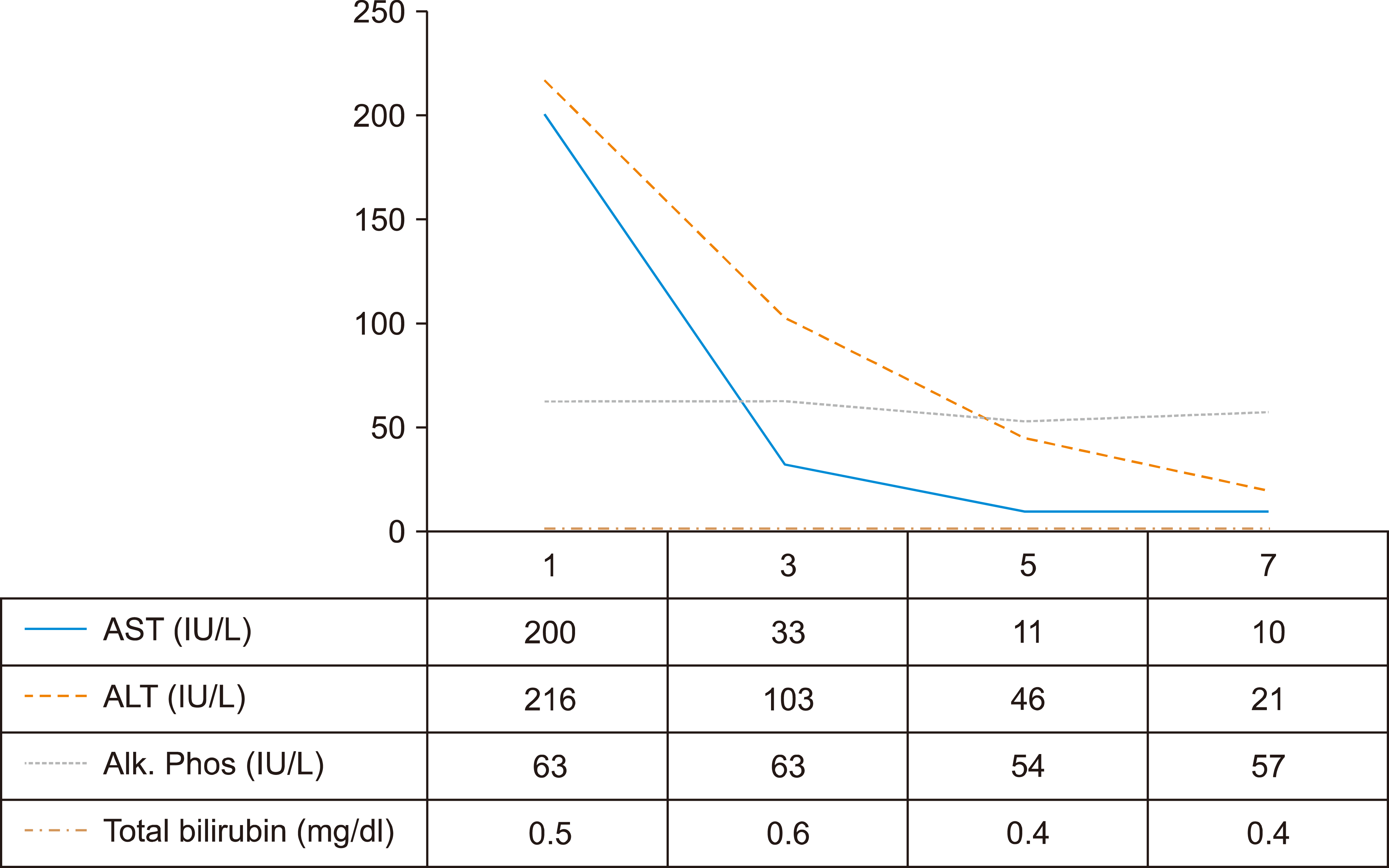1. Conroy T, Hammel P, Hebbar M, Abdelghani MB, Wei AC-c, Raoul JL, et al. 2018; Unicancer GI PRODIGE 24/CCTG PA.6 trial: a multicenter international randomized phase III trial of adjuvant mFOLFIRINOX versus gemcitabine (gem) in patients with resected pancreatic ductal adenocarcinomas. J Clin Oncol. 36(18 suppl):LBA4001. DOI:
10.1200/JCO.2018.36.18_suppl.LBA4001.

2. Neoptolemos JP, Stocken DD, Friess H, Bassi C, Dunn JA, Hickey H, et al. 2004; A randomized trial of chemoradiotherapy and chemotherapy after resection of pancreatic cancer. N Engl J Med. 350:1200–1210. DOI:
10.1056/NEJMoa032295. PMID:
15028824.

3. Oettle H, Neuhaus P, Hochhaus A, Hartmann JT, Gellert K, Ridwelski K, et al. 2013; Adjuvant chemotherapy with gemcitabine and long-term outcomes among patients with resected pancreatic cancer: the CONKO-001 randomized trial. JAMA. 310:1473–1481. DOI:
10.1001/jama.2013.279201. PMID:
24104372.
5. Kasumova GG, Conway WC, Tseng JF. 2018; The role of venous and arterial resection in pancreatic cancer surgery. Ann Surg Oncol. 25:51–58. DOI:
10.1245/s10434-016-5676-3. PMID:
27882472.

6. Wang JF, Zhai RY, Wei BJ, Li JJ, Jin WH, Dai DK, et al. 2006; Percutaneous intravascular stents for treatment of portal venous stenosis after liver transplantation: midterm results. Transplant Proc. 38:1461–1462. DOI:
10.1016/j.transproceed.2006.02.113. PMID:
16797333.

7. Kim KR, Ko GY, Sung KB, Yoon HK. 2011; Percutaneous transhepatic stent placement in the management of portal venous stenosis after curative surgery for pancreatic and biliary neoplasms. AJR Am J Roentgenol. 196:W446–W450. DOI:
10.2214/AJR.10.5274. PMID:
21427310.

8. Zhou ZQ, Lee JH, Song KB, Hwang JW, Kim SC, Lee YJ, et al. 2014; Clinical usefulness of portal venous stent in hepatobiliary pancreatic cancers. ANZ J Surg. 84:346–352. DOI:
10.1111/ans.12046. PMID:
23421858.

9. Ohgi K, Sugiura T, Yamamoto Y, Okamura Y, Ito T, Ashida R, et al. 2019; Benign portal vein stenosis after pancreaticoduodenectomy. World J Surg. 43:2623–2630. DOI:
10.1007/s00268-019-05070-3. PMID:
31243526.

10. Park KB, Choo SW, Do YS, Shin SW, Cho SG, Choo IW. 2005; Percutaneous angioplasty of portal vein stenosis that complicates liver transplantation: the mid-term therapeutic results. Korean J Radiol. 6:161–166. DOI:
10.3348/kjr.2005.6.3.161. PMID:
16145291. PMCID:
PMC2685039.

11. Jeon UB, Kim CW, Kim TU, Choo KS, Jang JY, Nam KJ, et al. 2016; Therapeutic efficacy and stent patency of transhepatic portal vein stenting after surgery. World J Gastroenterol. 22:9822–9828. DOI:
10.3748/wjg.v22.i44.9822. PMID:
27956806. PMCID:
PMC5124987.

12. Nakao A, Nonami T, Harada A, Kasuga T, Takagi H. 1990; Portal vein resection with a new antithrombogenic catheter. Surgery. 108:913–918. PMID:
2237772.
13. Nakao A, Takagi H. 1993; Isolated pancreatectomy for pancreatic head carcinoma using catheter bypass of the portal vein. Hepatogastroenterology. 40:426–429. PMID:
8270230.
14. Bachellier P, Rosso E, Fuchshuber P, Addeo P, David P, Oussoultzoglou E, et al. 2014; Use of a temporary intraoperative mesentericoportal shunt for pancreatic resection for locally advanced pancreatic cancer with portal vein occlusion and portal hypertension. Surgery. 155:449–456. DOI:
10.1016/j.surg.2013.09.003. PMID:
24462078.

15. Scheufele F, Hartmann D, Friess H. 2019; Treatment of pancreatic cancer-neoadjuvant treatment in borderline resectable/locally advanced pancreatic cancer. Transl Gastroenterol Hepatol. 4:32. DOI:
10.21037/tgh.2019.04.09. PMID:
31231699. PMCID:
PMC6556697.

16. Scemama U, Birnbaum DJ, Ouaissi M, Turrini O, Moutardier V, Soussan J. 2016; Portal vein stent placement in five patients with chronic portal vein thrombosis prior to pancreatic surgery. J Vasc Interv Radiol. 27:889–894. DOI:
10.1016/j.jvir.2015.11.057. PMID:
27287970.

17. Alden D, Dudiy Y, Nassiri N, Friedland RJ, Amatulle P, Rosen RJ. 2015; Direct percutaneous transhepatic portomesenteric venous stenting in management of locally advanced pancreatic cancer. Am J Clin Oncol. 38:127–129. DOI:
10.1097/COC.0b013e31828f5c82. PMID:
23608832.

18. Fortner JG. 1973; Regional resection of cancer of the pancreas: a new surgical approach. Surgery. 73:307–320. PMID:
4265314.
19. Dasari BV, Pasquali S, Vohra RS, Smith AM, Taylor MA, Sutcliffe RP, et al. 2015; Extended versus standard lymphadenectomy for pancreatic head cancer: meta-analysis of randomized controlled trials. J Gastrointest Surg. 19:1725–1732. DOI:
10.1007/s11605-015-2859-3. PMID:
26055135.

20. Delpero JR, Sauvanet A. 2020; Vascular resection for pancreatic cancer: 2019 French recommendations based on a literature review from 2008 to 6-2019. Front Oncol. 10:40. DOI:
10.3389/fonc.2020.00040. PMID:
32117714. PMCID:
PMC7010716.

21. Neoptolemos JP, Palmer DH, Ghaneh P, Psarelli EE, Valle JW, Halloran CM, et al. 2017; Comparison of adjuvant gemcitabine and capecitabine with gemcitabine monotherapy in patients with resected pancreatic cancer (ESPAC-4): a multicentre, open-label, randomised, phase 3 trial. Lancet. 389:1011–1024. DOI:
10.1016/S0140-6736(16)32409-6. PMID:
28129987.






 PDF
PDF Citation
Citation Print
Print




 XML Download
XML Download